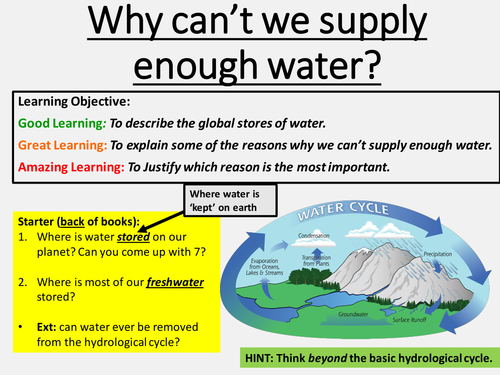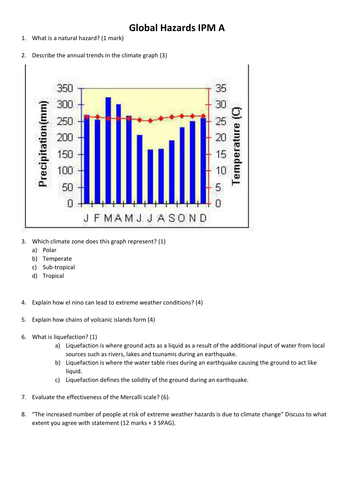
60Uploads
20k+Views
3k+Downloads
Geography

Goat Aid, Tanzania Case Study Card
Case Study sheet to be filled in on Goat Aid, Tanzania and how it has influenced food security. For the Resource Reliance topic of OCR B GCSE. Used in conjunction with the Oxford textbook.

Tanzania Food Security Case Study Card
Case Study sheet to be filled in on the background issues of Tanzania and food security. For the Resource Reliance topic of OCR B GCSE. Used in conjunction with the Oxford textbook.

New OCR B GCSE - Water Security
Lesson on why we can't supply enough water for the Resource Reliance topics for OCR B. Includes a detailed lesson plan power point and worksheet.

NEW OCR GCSE - Natural hazards: Assessment
Full scheme of work for the natural hazards assessment and mark scheme.

NEW OCR GCSE -Natural Hazards - Volcanoes
A lesson investigating the formation and characteristics of shield volcanoes, composite volcanoes and hotspots. Aimed at top grade students but easily adapted for the less able.

NEW OCR GCSE - Natural hazards: Plan, predict, prepare
A lesson examining how technology can help save lives in tectonic zones, looking specifically at the 3 P's for earthquakes. Aimed at the top grade students but easily adapted for the less able.

NEW OCR GCSE - Natural Hazards: Nepal Earthquake Case Study
A lesson on the recent Nepal earthquake looking at causes, impacts and responses. Includes presentation, case study card for students and an additional sheet with responses on. Aimed at top grade students but is easily adapted for the less able.

NEW OCR GCSE -Natural Hazards: Measuring earthquakes
A lesson looking at and evaluating the Mercalli and Richter scale. Aimed at top grade students but easily adapted for the less able.

NEW OCR GCSE - Natural Hazards: Earthquakes
Lesson on how earthquakes occur and their primary and secondary effects. Aimed at top grade students but easily adapted for the less able

NEW OCR GCSE - Natural Hazards: Plate boundaries
Lesson on the different types of plate boundaries and the processes occurring at them. Aimed at top grade students but easily adapted for the less able.

NEW OCR GCSE - Natural Hazards: Earth's structure
Lesson on the Earth's structure including the characteristics of each layer and a continental drift based homework. Aimed at top grade students but easily adapted for the less able.

NEW OCR GCSE - Natural Hazards: Case Study of Cyclone Aila
Case study lesson of a tropical storm (Cyclone Aila, Bangladesh). Includes information sheets, case study cards, exam practise and powerpoint. Aimed at top grade students but easily adapted for the less able.

NEW OCR GCSE - Natural Hazards - Tropical Storms
A lesson on what tropical storms are (hurricanes, typhoons, cyclones), where they are found, how they are formed and how they are measured. Includes a presentation, worksheet and homework. Aimed at top grade students but easily adaptable for the less able.

NEW OCR GCSE - Natural Hazards: UK 2012 Drought, Case Study
A case study of the UK 2012 drought for the Natural Hazards unit. Includes presentation, student worksheet and information pack. Aimed at top grade students but easily adapted for the less able.

NEW OCR GCSE -Natural Hazards: Causes of drought
A lesson for the new OCR GCSE on the various causes of drought as well as looking at their change in frequency and magnitude over time. Aimed at top grade students but easily adapted for the less able. Includes worksheets and teacher answers as well as a power point.

NEW OCR GCSE - Natural Hazards: Climate Belts
A lesson on mapping the global climate belts and investigating extreme temperature, wind and rainfall across the world. It looks at the interaction between the global circulation model and climate. Aimed at high ability students but easily adapted for the less able. Worksheet and detailed resource packs included at the end of the power point.

NEW OCR GCSE: Natural Hazards - Atmospheric Circulation
An introductory lesson to the topic including the tri-cellular model of atmospheric circulation. Aimed at top grade students (7/8/9) and easily adaptable for the less able.

NEW OCR A-LEVEl - Earth Life Support Systems: Lapse rates and cloud formation
A lesson for the new ocr (2016) a-level on lapse rates and cloud formation. Aimed at A/A* level so lots of detail and information on the technicalities of airs movement in the troposphere. Includes detailed information on lapse rates, cloud formation and precipitation for the water and carbon based topic 'Earth Life Support Systems'.

Urban Growth Lesson (Setlemenet KS3)
A lesson introducing push and pull factors for settlements and exploring the idea of why settlements grow. Includes full powerpoint (with detailed notes section), lesson plan, card sort and worksheet. This is for high ability year 7 so could be easily adapted for year 8 too.

NEW OCR B A-level. Case Study of a Low Energy Coastline: New Zealand.
New OCR B A-level. Case study of a low energy coastline not in the UK. Focuses on farewell spit and golden bay in New Zealand including place specific formation of landforms, how the landscape system is inter-related and how these landforms change over time. Aimed at higher ability year 12/13 but easily adaptable for less able pupils.




















